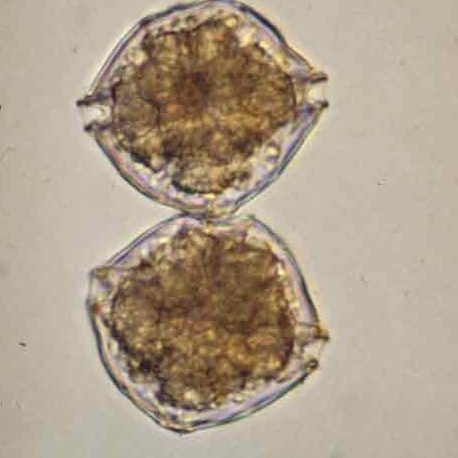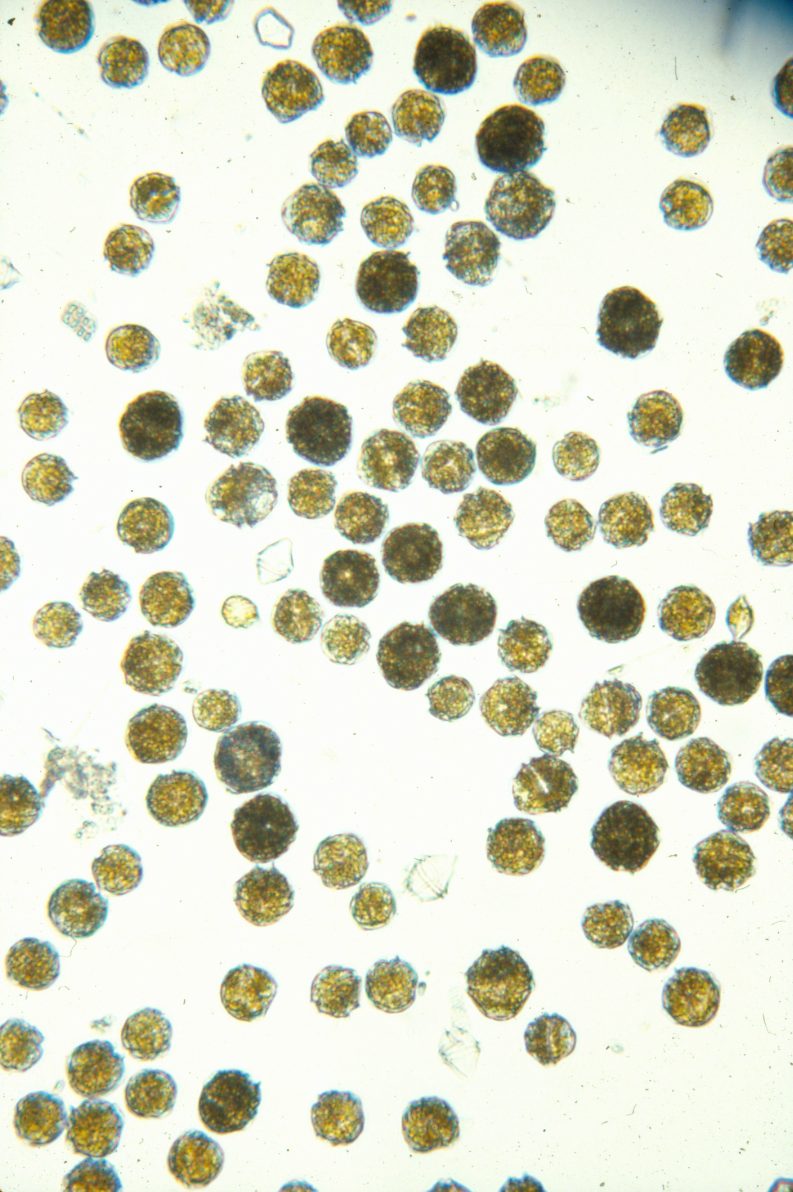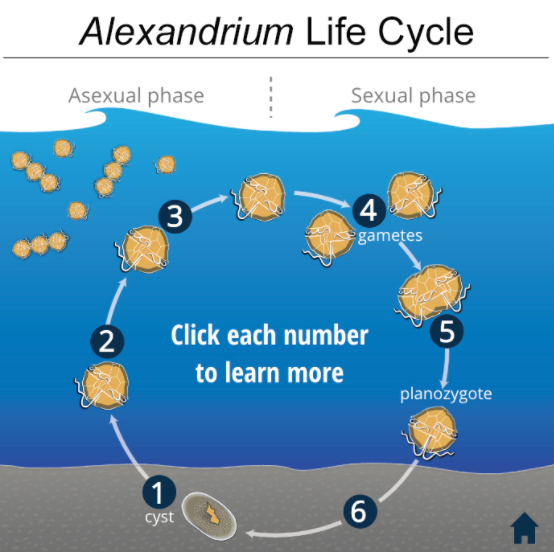
Alexandrium catenella ( WHOI, D. Anderson)
Alexandrium
- Bloom forming dinoflagellate genus
- More than 30 recognized species
- Found globally in coastal waters
- Certain species produce saxitoxins, which may lead to:
- Human poisoning cases - Paralytic Shellfish Poisoning (PSP)
- Economic losses in aquaculture and fisheries industries
- Marine animal mortalities
- Food web disruptions
Morphology & Ecology
The genus Alexandrium is a particularly well-known group of bloom-forming marine dinoflagellates due to their impacts on human health. This genus is globally distributed, and can be found in sub-polar, temperate, and tropical coastal waters. Currently there are more than 30 recognized species and three well supported species complexes. Species within this genus previously were identified by their size and thecal plate structure, but with the advance of molecular phylogenetic analyses the taxonomy of this genus has frequently been revised.
In nature, the roughly spherical Alexandrium cells may be found as individuals or in short chains in rapidly growing populations. Each cell has two flagella, which they use to migrate vertically in the water column depending on light intensity, time of day, and water movement, allowing them to inhabit optimum growing conditions. They are predominantly autotrophs, relying on photosynthesis, but a few species are mixotrophic under specific life phases and conditions. The dark to reddish brown cells of these species can vary in size from 20- 80 µm in diameter and therefore are not visible with the naked eye unless in high concentrations, which can discolor coastal waters and produce what are often referred to as "red tides" or harmful algal blooms. Occasionally, blooms can even be bioluminescent, although it is extremely variable depending on the population.
Like many dinoflagellates, Alexandrium species have two main life history phases: a planktonic phase where motile cells are in the water column at various reproductive stages, and their cystic life phase where they lie dormant in the sediments. This alternating life cycle allows the species to survive as cysts during unfavorable growing conditions such as cold winter water temperatures, and in some locations high concentration of cysts accumulate and establish a seed bank that initiates recurring blooms year after year. In some regions, researchers map the location and abundance of these benthic cysts, and use these data to predict and model bloom dynamics. Alexandrium blooms occur seasonally and are influenced by a multitude of abiotic conditions from temperature, salinity, nutrient availability and even weather patterns. They also are impacted by biological factors including predation, infection from viruses, bacteria, parasites or cell encystment. Many scientists around the world research the conditions that promote bloom duration and development to model and predict future blooms as they can be detrimental to human health and fisheries.
Impacts & Toxicity
About half of known Alexandrium species produce a suite of paralytic shellfish toxins (PSTs), of which saxitoxin is the most potent. Saxitoxins (STXs) are neurotoxins that bind voltage-gated sodium channels in cell membranes, inhibiting membrane depolarization and action potentials. These species produce additional toxic compounds, such as spirolides and gymnodimines, although these have not been linked to human health problems. In humans, consumption of seafood contaminated with PSTs causes Paralytic Shellfish Poisoning (PSP), characterized by neurological symptoms that can be life-threatening. SXTs are stable in the presence of temperature extremes and pH changes, therefore cooking seafood does not eliminate the risk of illness. Human poisoning events are generally linked to contaminated shellfish. Bioaccumulation of PSTs occurring in marine mammals, birds, and fish can be lethal, leading to mass wildlife mortality and food web disruptions. When Alexandrium blooms cause toxicity in a region, specific shellfish fisheries are often required to temporarily close until and toxin levels drop. Fishery closures are based on toxin monitoring action levels set by the USFDA of 80 micrograms, or more, per 100 grams shellfish meat, which is bioanalyzed by current Association of Official Analytical Chemists procedures.
Environmental factors can impact the amount of toxins produced during an Alexandrium bloom, which makes monitoring toxicity particularly challenging for researchers as the presence of a toxic species alone does not indicate the need to close fisheries. The reason STXs are produced by Alexandrium species is not altogether clear, yet there are few hypotheses: from acting as a grazing deterrent by other planktonic organisms, helping regulating bloom dynamics or even potentially assisting with chromosome structure, although, no strong evidence supports one over the other.
Resources & References

Publications
- Anderson, D.M. 1997. Bloom dynamics of toxic Alexandrium species in the northeastern U.S. Limnology and Oceanography 42(1009-1022)
- Anderson, D. M., Alpermann, T. J., Cembella, A. D., Collos, Y., Masseret, E., & Montresor, M. 2012. The globally distributed genus Alexandrium: multifaceted roles in marine ecosystems and impacts on human health. Harmful algae. 14 (10-35).
- Brosnahan, M. L., Fischer, A. D., Lopez, C. B., Moore, S. K., & Anderson, D. M. 2020. Cyst-forming dinoflagellates in a warming climate. Harmful Algae 91.
- Lewitus, A. J., Horner, R. A., Caron, D. A., Garcia-Mendoza, E., Hickey, B. M., Hunter, M. & Lessard, E. J. 2012. Harmful algal blooms along the North American west coast region: History, trends, causes, and impacts. Harmful algae. 19(133-159).
Fact Sheets
Distribution in the U.S.
Alexandrium species are distributed throughout coastal waters around the United States (see PSP map). Blooms occur along the East Coast from Maine to New Jersey and along the West Coast from Alaska to California, often in the late spring and summer. Although widespread, these blooms are not uniform within these regions due to discrete hydrographic regimes or habitats, each with a unique set of environmental and oceanographic conditions that impact Alexandrium populations. In the Pacific Northwest, early records indicate PSP presence for hundreds to potentially thousands of years. Despite this long record of outbreaks, it was not until 1965 that Alexandrium specifically was linked to PSP illness and fatalities after consumption of shellfish in Washington. Blooms appeared in the northeastern U.S. several decades ago, with the first report of PSP occurring in Northern Maine in 1958. Since then, Alexandrium blooms have become widespread along the coast of New England and occur seasonally. Today along both coasts, states have established thorough monitoring programs for PSP toxicity and enact shellfish fishery closures to safeguard public health.

Widespread bloom of A. monilatum in the lower Chesapeake Bay (W. Vogelbein, VIMS).

